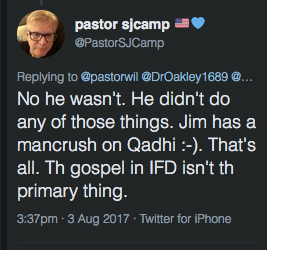We have already seen that Brown relies heavily upon a highly doubtful, uncritical, easily challenged view of extra-biblical sources such as the Nag Hammadi Library and various other gnostic-influenced works. Ironically, Brown contradicts himself once again in his statements immediately following the embarrassing “heretic” comment on page 234. Here Brown speaking as Teabing says that “some of the gospels that Constantine attempted to eradicate managed to survive.” And what does he refer to? First he mentions the Dead Sea Scrolls, which, of course, are Jewish in nature and origin, not Christian. Now, if he would like to argue that 7Q5 is, in fact, a fragment of the Gospel of Mark, making the DSS relevant, that’s fine—that would only destroy his entire thesis once again, putting Mark’s writing within a few years of the events themselves. But obviously, that is not his intention, so, even mentioning the DSS is utterly irrelevant. Next he lists the Nag Hammadi finds, which of course contain some of his favorite sources, all from the second century, of course. He claims that both the DSS and the Nag Hammadi library tell “the true Grail story.” I’m sure those working on the Dead Sea Scrolls need to be informed of this, since they would not have any idea of that otherwise! And one thing can be said with all certainty regarding the Nag Hammadi Library: there is no single story, no single position, to be found in that collection of works. They were not “gospels” representing the early Christian religion amongst the “thousands” Brown has alleged: they are the works of those who sought to pervert and change the faith, joining elements of Christianity with foreign beliefs.
Brown goes on to claim the DSS and Nag Hammadi finds “speak of Christ’s ministry in very human terms” (234). Again, I would love to see where the DSS speak of Christ’s ministry period, but be that as it may, in reality, once you leave the inspired text, you can find anything you want in second century writings about Christ. In fact, the deity of Christ is prominent in these works. The Docetics, for example, loved to speculate on what Christ would be like as a god (without a true physical body), and some of their myths and legends even ended up in the Qur’an! Surahs 3:49 and 5:110 both make reference to Jesus allegedly making birds of clay come alive, a story found in the Infancy Gospel of Thomas:
The stories of Thomas the Israelite, the Philosopher, concerning the works of the Childhood of the Lord.
I. I, Thomas the Israelite, tell unto you, even all the brethren that are of the Gentiles, to make known unto you the works of the childhood of our Lord Jesus Christ and his mighty deeds, even all that he did when he was born in our land: whereof the beginning is thus:
II. 1 This little child Jesus when he was five years old was playing at the ford of a brook: and he gathered together the waters that flowed there into pools, and made them straightway clean, and commanded them by his word alone. 2 And having made soft clay, he fashioned thereof twelve sparrows. And it was the Sabbath when he did these things (or made them). And there were also many other little children playing with him.
3 And a certain Jew when he saw what Jesus did, playing upon the Sabbath day, departed straightway and told his father Joseph: Lo, thy child is at the brook, and he hath taken clay and fashioned twelve little birds, and hath polluted the Sabbath day. 4 And Joseph came to the place and saw: and cried out to him, saying: Wherefore doest thou these things on the Sabbath, which it is not lawful to do? But Jesus clapped his hands together and cried out to the sparrows and said to them: Go! and the sparrows took their flight and went away chirping. 5 And when the Jews saw it they were amazed, and departed and told their chief men that which they had seen Jesus do.
Sorry, but that doesn’t sound like an overly “human” Jesus vs. a divine Jesus (in the context in which Brown is speaking). Brown alleges,
The scrolls highlight glaring historical discrepancies and fabrications, clearly confirming that the modern Bible was compiled and edited by men who possessed a political agenda—to promote the divinity of the man Jesus Christ and use His influence to solidify their own power base. (234)
Actually, to anyone familiar with these disparate, contradictory, second-century sources, that anyone could possibly think them relevant to Brown’s fanciful theories is what is truly amazing. These sources contain a “divine” Jesus to begin with! Has Brown not even read these sources himself? The massive leap from “gnostics wrote second century documents” to “the Bible was compiled and edited (in the days of Constantine) by men who possessed a political agenda—to promote the divinity of the man Jesus Christ” is simply breathtaking. Brown doesn’t bother attempting to provide a foundation—-there is none, of course. But given the complete lack of foundation to this point, and the pile of utter falsehoods we have already documented, we are still left to wonder just how the upcoming film will handle quotes like this, and how many people will fall for them, hook, line, and sinker, so that you will find yourself hearing this kind of rhetoric repeated back to you when you seek to share the message of life with others?



